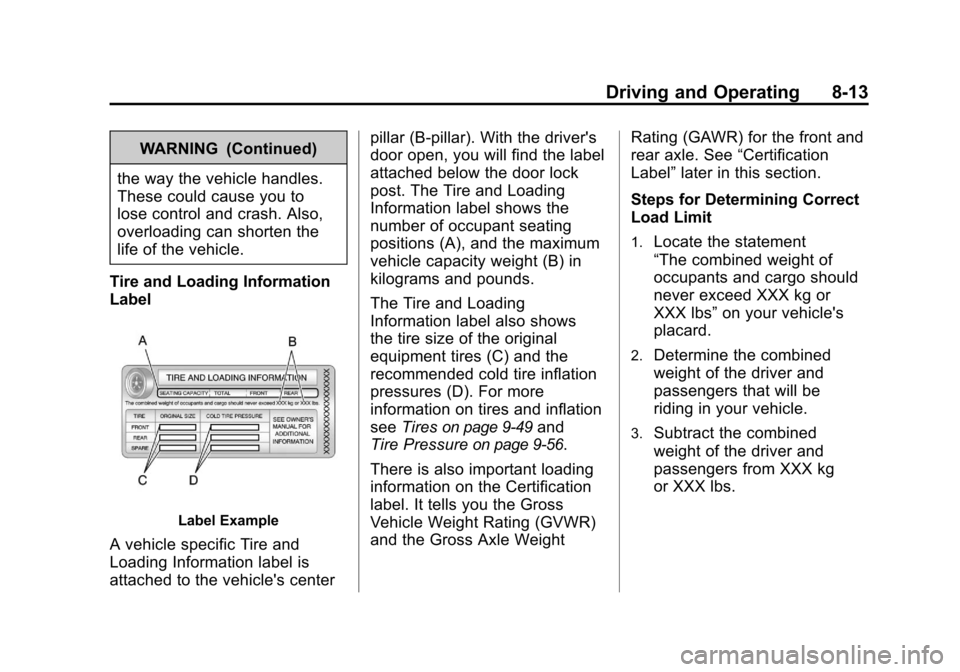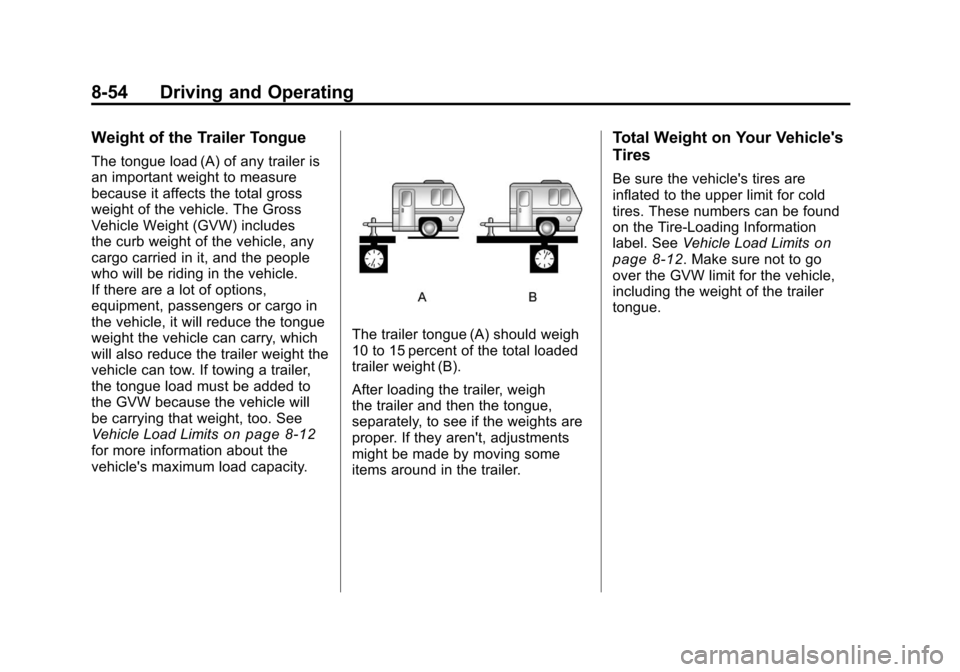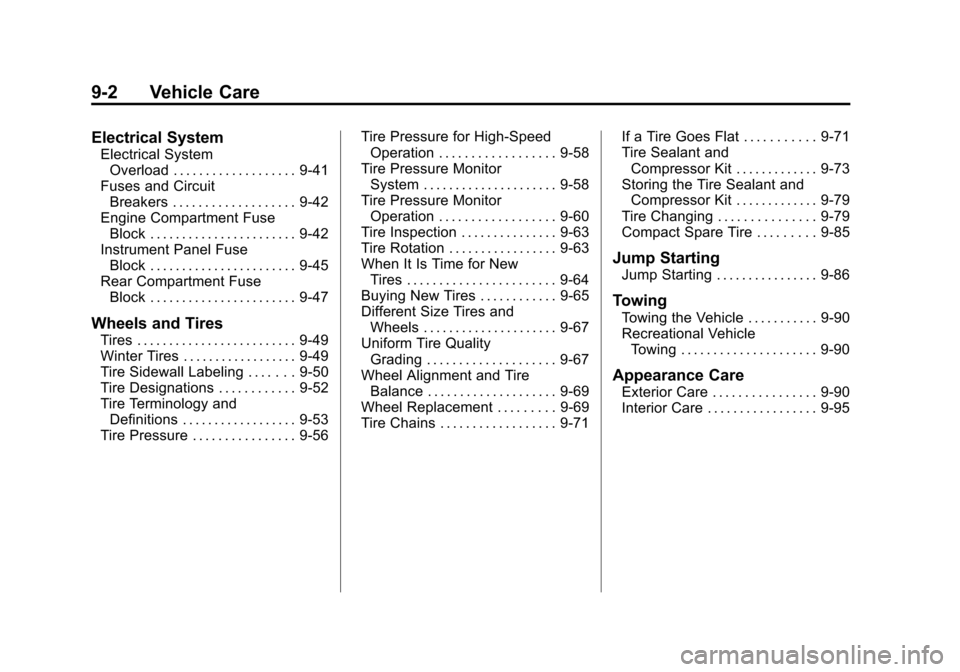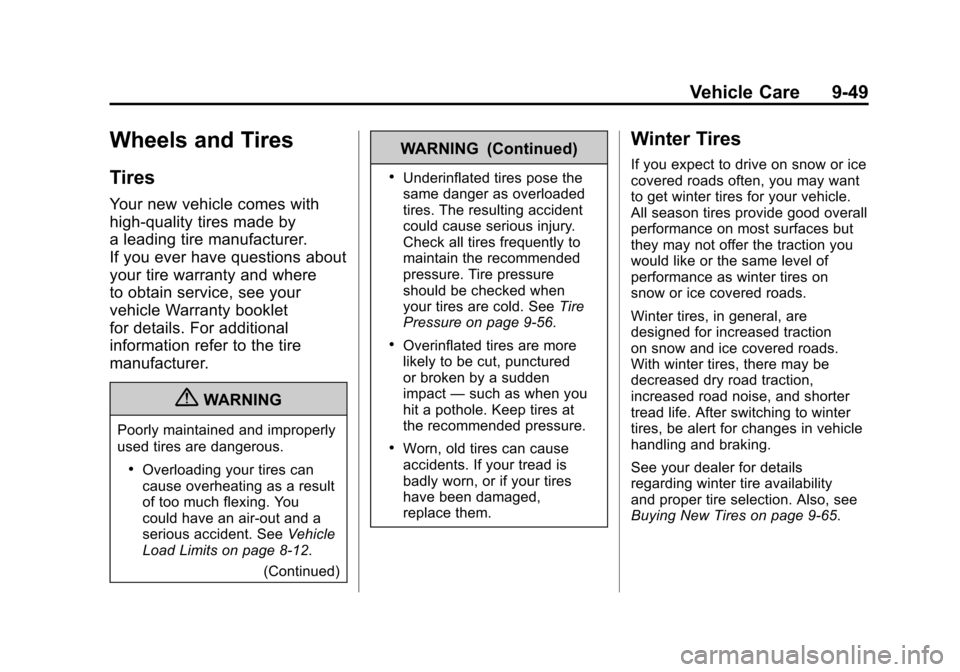2010 CHEVROLET CAMARO flat tire
[x] Cancel search: flat tirePage 108 of 378

Black plate (26,1)Chevrolet Camaro Owner Manual - 2010
4-26 Instruments and Controls
Tire Pressure Light
For vehicles with a Tire Pressure
Monitor System, this light comes on
briefly when the engine is started.
It provides information about tire
pressures and the Tire Pressure
Monitor System.
When the Light is On Steady
This indicates that one or more
of the tires are significantly
underinflated.
A tire pressure message can
accompany the light. SeeTire
Messages
on page 4‑36for more
information. Stop as soon as
possible, and inflate the tires to
the pressure value shown on the
Tire and Loading Information Label.
See Tire Pressure
on page 9‑56for
more information. When the Light Flashes First and
Then is On Steady
This indicates that there may be a
problem with the Tire Pressure
Monitor System. The light flashes
for about a minute and stays on
steady for the remainder of the
ignition cycle. This sequence
repeats with every ignition cycle.
See
Tire Pressure Monitor
Operation
on page 9‑60for
more information.
Engine Oil Pressure Light
{WARNING
Do not keep driving if the oil
pressure is low. The engine can
become so hot that it catches fire.
Someone could be burned. Check
the oil as soon as possible and
have the vehicle serviced. Notice:
Lack of proper engine oil
maintenance can damage the
engine. The repairs would not be
covered by the vehicle warranty.
Always follow the maintenance
schedule in this manual for
changing engine oil.
The oil pressure light should come
on briefly as the engine is started.
If it does not come on have the
vehicle serviced by your dealer.
If the light comes on and stays on, it
means that oil is not flowing through
the engine properly. The vehicle
could be low on oil and might have
some other system problem. See
your dealer.
Page 178 of 378

Black plate (2,1)Chevrolet Camaro Owner Manual - 2010
8-2 Driving and Operating
Fuel
Fuel . . . . . . . . . . . . . . . . . . . . . . . . . 8-43
Recommended Fuel . . . . . . . . . 8-44
Gasoline Specifications . . . . . . 8-44
California FuelRequirements . . . . . . . . . . . . . . 8-45
Fuels in Foreign Countries . . . 8-45
Fuel Additives . . . . . . . . . . . . . . . 8-45
Filling the Tank . . . . . . . . . . . . . . 8-46
Filling a Portable Fuel Container . . . . . . . . . . . . . . . . . . . 8-48
Towing
General TowingInformation . . . . . . . . . . . . . . . . . 8-48
Driving Characteristics and Towing Tips . . . . . . . . . . . . . . . . 8-49
Trailer Towing . . . . . . . . . . . . . . . . 8-53
Towing Equipment . . . . . . . . . . . 8-55
Conversions and Add-Ons
Add-On Electrical
Equipment . . . . . . . . . . . . . . . . . 8-55
Driving Information
Driving for Better Fuel
Economy
Driving habits can affect fuel
mileage. Here are some driving
tips to get the best fuel economy
possible.
.Avoid fast starts and accelerate
smoothly.
.Brake gradually and avoid
abrupt stops.
.Avoid idling the engine for long
periods of time.
.When road and weather
conditions are appropriate,
use cruise control, if equipped.
.Always follow posted speed
limits or drive more slowly when
conditions require.
.Keep vehicle tires properly
inflated.
.Combine several trips into a
single trip.
.Replace the vehicle's tires with
the same TPC Spec number
molded into the tire's sidewall
near the size.
.Follow recommended scheduled
maintenance.
Page 185 of 378

Black plate (9,1)Chevrolet Camaro Owner Manual - 2010
Driving and Operating 8-9
Other Rainy Weather Tips
Besides slowing down, other wet
weather driving tips include:
.Allow extra following distance.
.Pass with caution.
.Keep windshield wiping
equipment in good shape.
.Keep the windshield washer fluid
reservoir filled.
.Have good tires with proper
tread depth. SeeTireson
page 9‑49.
.Turn off cruise control.
Highway Hypnosis
Always be alert and pay attention
to your surroundings while driving.
If you become tired or sleepy, find
a safe place to park your vehicle
and rest.
Other driving tips include:
.Keep the vehicle well ventilated.
.Keep interior temperature cool.
.Keep your eyes moving —scan
the road ahead and to the sides.
.Check the rearview mirror and
vehicle instruments often.
Hill and Mountain Roads
Driving on steep hills or through
mountains is different than driving
on flat or rolling terrain. Tips for
driving in these conditions include:
.Keep the vehicle serviced and in
good shape.
.Check all fluid levels and brakes,
tires, cooling system, and
transmission.
.Shift to a lower gear when going
down steep or long hills.
{WARNING
If you do not shift down, the
brakes could get so hot that they
would not work well. You would
then have poor braking or even
(Continued)
WARNING (Continued)
none going down a hill. You could
crash. Shift down to let the engine
assist the brakes on a steep
downhill slope.
{WARNING
Coasting downhill in N (Neutral)
or with the ignition off is
dangerous. The brakes will have
to do all the work of slowing down
and they could get so hot that
they would not work well. You
would then have poor braking
or even none going down a hill.
You could crash. Always have the
engine running and the vehicle in
gear when going downhill.
.Stay in your own lane. Do not
swing wide or cut across the
center of the road. Drive at
speeds that let you stay in
your own lane.
Page 189 of 378

Black plate (13,1)Chevrolet Camaro Owner Manual - 2010
Driving and Operating 8-13
WARNING (Continued)
the way the vehicle handles.
These could cause you to
lose control and crash. Also,
overloading can shorten the
life of the vehicle.
Tire and Loading Information
Label
Label Example
A vehicle specific Tire and
Loading Information label is
attached to the vehicle's center pillar (B-pillar). With the driver's
door open, you will find the label
attached below the door lock
post. The Tire and Loading
Information label shows the
number of occupant seating
positions (A), and the maximum
vehicle capacity weight (B) in
kilograms and pounds.
The Tire and Loading
Information label also shows
the tire size of the original
equipment tires (C) and the
recommended cold tire inflation
pressures (D). For more
information on tires and inflation
see
Tires
on page 9‑49and
Tire Pressure
on page 9‑56.
There is also important loading
information on the Certification
label. It tells you the Gross
Vehicle Weight Rating (GVWR)
and the Gross Axle Weight Rating (GAWR) for the front and
rear axle. See
“Certification
Label” later in this section.
Steps for Determining Correct
Load Limit
1.Locate the statement
“The combined weight of
occupants and cargo should
never exceed XXX kg or
XXX lbs” on your vehicle's
placard.
2.Determine the combined
weight of the driver and
passengers that will be
riding in your vehicle.
3.Subtract the combined
weight of the driver and
passengers from XXX kg
or XXX lbs.
Page 230 of 378

Black plate (54,1)Chevrolet Camaro Owner Manual - 2010
8-54 Driving and Operating
Weight of the Trailer Tongue
The tongue load (A) of any trailer is
an important weight to measure
because it affects the total gross
weight of the vehicle. The Gross
Vehicle Weight (GVW) includes
the curb weight of the vehicle, any
cargo carried in it, and the people
who will be riding in the vehicle.
If there are a lot of options,
equipment, passengers or cargo in
the vehicle, it will reduce the tongue
weight the vehicle can carry, which
will also reduce the trailer weight the
vehicle can tow. If towing a trailer,
the tongue load must be added to
the GVW because the vehicle will
be carrying that weight, too. See
Vehicle Load Limits
on page 8‑12for more information about the
vehicle's maximum load capacity.
The trailer tongue (A) should weigh
10 to 15 percent of the total loaded
trailer weight (B).
After loading the trailer, weigh
the trailer and then the tongue,
separately, to see if the weights are
proper. If they aren't, adjustments
might be made by moving some
items around in the trailer.
Total Weight on Your Vehicle's
Tires
Be sure the vehicle's tires are
inflated to the upper limit for cold
tires. These numbers can be found
on the Tire-Loading Information
label. SeeVehicle Load Limits
on
page 8‑12. Make sure not to go
over the GVW limit for the vehicle,
including the weight of the trailer
tongue.
Page 234 of 378

Black plate (2,1)Chevrolet Camaro Owner Manual - 2010
9-2 Vehicle Care
Electrical System
Electrical SystemOverload . . . . . . . . . . . . . . . . . . . 9-41
Fuses and Circuit Breakers . . . . . . . . . . . . . . . . . . . 9-42
Engine Compartment Fuse
Block . . . . . . . . . . . . . . . . . . . . . . . 9-42
Instrument Panel Fuse Block . . . . . . . . . . . . . . . . . . . . . . . 9-45
Rear Compartment Fuse Block . . . . . . . . . . . . . . . . . . . . . . . 9-47
Wheels and Tires
Tires . . . . . . . . . . . . . . . . . . . . . . . . . 9-49
Winter Tires . . . . . . . . . . . . . . . . . . 9-49
Tire Sidewall Labeling . . . . . . . 9-50
Tire Designations . . . . . . . . . . . . 9-52
Tire Terminology andDefinitions . . . . . . . . . . . . . . . . . . 9-53
Tire Pressure . . . . . . . . . . . . . . . . 9-56 Tire Pressure for High-Speed
Operation . . . . . . . . . . . . . . . . . . 9-58
Tire Pressure Monitor System . . . . . . . . . . . . . . . . . . . . . 9-58
Tire Pressure Monitor
Operation . . . . . . . . . . . . . . . . . . 9-60
Tire Inspection . . . . . . . . . . . . . . . 9-63
Tire Rotation . . . . . . . . . . . . . . . . . 9-63
When It Is Time for New Tires . . . . . . . . . . . . . . . . . . . . . . . 9-64
Buying New Tires . . . . . . . . . . . . 9-65
Different Size Tires and Wheels . . . . . . . . . . . . . . . . . . . . . 9-67
Uniform Tire Quality Grading . . . . . . . . . . . . . . . . . . . . 9-67
Wheel Alignment and Tire Balance . . . . . . . . . . . . . . . . . . . . 9-69
Wheel Replacement . . . . . . . . . 9-69
Tire Chains . . . . . . . . . . . . . . . . . . 9-71 If a Tire Goes Flat . . . . . . . . . . . 9-71
Tire Sealant and
Compressor Kit . . . . . . . . . . . . . 9-73
Storing the Tire Sealant and Compressor Kit . . . . . . . . . . . . . 9-79
Tire Changing . . . . . . . . . . . . . . . 9-79
Compact Spare Tire . . . . . . . . . 9-85
Jump Starting
Jump Starting . . . . . . . . . . . . . . . . 9-86
Towing
Towing the Vehicle . . . . . . . . . . . 9-90
Recreational Vehicle Towing . . . . . . . . . . . . . . . . . . . . . 9-90
Appearance Care
Exterior Care . . . . . . . . . . . . . . . . 9-90
Interior Care . . . . . . . . . . . . . . . . . 9-95
Page 266 of 378

Black plate (34,1)Chevrolet Camaro Owner Manual - 2010
9-34 Vehicle Care
The vehicle should be properly
prepared as follows:
.The vehicle should be placed so
the headlamps are 7.6 m (25 ft)
from a light colored wall.
.The vehicle must have all four
tires on a level surface which is
level all the way to the wall.
.The vehicle should be placed so
it is perpendicular to the wall or
other flat surface.
.The vehicle should not have any
snow, ice, or mud on it.
.The vehicle should be fully
assembled and all other work
stopped while headlamp aiming
is being performed.
.The vehicle should be normally
loaded with a full tank of fuel and
one person or 75 kg (160 lbs)
sitting on the driver's seat.
.Tires should be properly inflated.Headlamp aiming is done with the
vehicle's low-beam headlamps.
The high-beam headlamps will be
correctly aimed if the low-beam
headlamps are aimed properly.
To adjust the vertical aim:
1. Open the hood. See
Hood
on
page 9‑5for more information.
Halogen Headlamp
HID Headlamp
2. Locate the aim dot on the lens of the low‐beam headlamp.
3. Measure the distance from the ground to the aim dot on the
low‐beam headlamp. Record
the distance.
Page 281 of 378

Black plate (49,1)Chevrolet Camaro Owner Manual - 2010
Vehicle Care 9-49
Wheels and Tires
Tires
Your new vehicle comes with
high-quality tires made by
a leading tire manufacturer.
If you ever have questions about
your tire warranty and where
to obtain service, see your
vehicle Warranty booklet
for details. For additional
information refer to the tire
manufacturer.
{WARNING
Poorly maintained and improperly
used tires are dangerous.
.Overloading your tires can
cause overheating as a result
of too much flexing. You
could have an air-out and a
serious accident. SeeVehicle
Load Limits on page 8‑12.
(Continued)
WARNING (Continued)
.Underinflated tires pose the
same danger as overloaded
tires. The resulting accident
could cause serious injury.
Check all tires frequently to
maintain the recommended
pressure. Tire pressure
should be checked when
your tires are cold. See Tire
Pressure on page 9‑56.
.Overinflated tires are more
likely to be cut, punctured
or broken by a sudden
impact —such as when you
hit a pothole. Keep tires at
the recommended pressure.
.Worn, old tires can cause
accidents. If your tread is
badly worn, or if your tires
have been damaged,
replace them.
Winter Tires
If you expect to drive on snow or ice
covered roads often, you may want
to get winter tires for your vehicle.
All season tires provide good overall
performance on most surfaces but
they may not offer the traction you
would like or the same level of
performance as winter tires on
snow or ice covered roads.
Winter tires, in general, are
designed for increased traction
on snow and ice covered roads.
With winter tires, there may be
decreased dry road traction,
increased road noise, and shorter
tread life. After switching to winter
tires, be alert for changes in vehicle
handling and braking.
See your dealer for details
regarding winter tire availability
and proper tire selection. Also, see
Buying New Tires on page 9‑65.